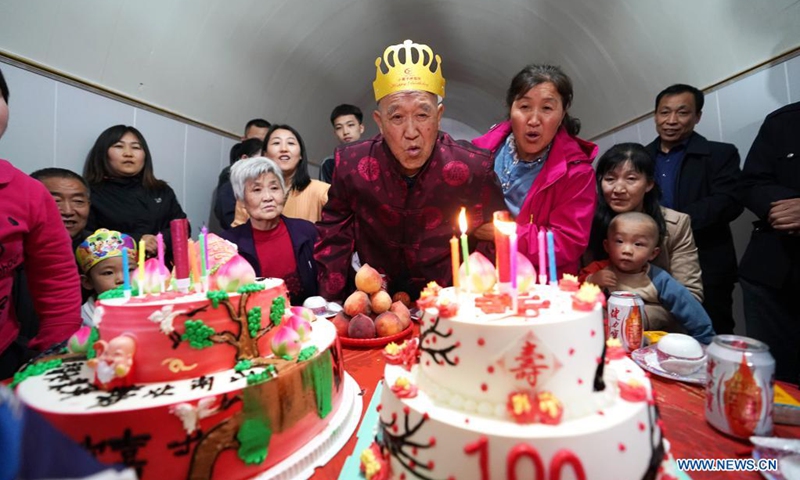Beijing's permanent population in central area decreases by 728,000 in 10 years, shows improved regional layout

Hu Zaizhong blows candles on his birthday cake at his birthday banquet on April 24, 2021. Hu Zaizhong, who has just turned 100, vividly remembers his wishes at different stages of his life: having decent food and clothing in his early days, teaching as many pupils as he could in his prime age, and enjoying quality time with his family for late years. (Photo: Xinhua)
As a part of the seventh national population census results, Beijing released its main data on Wednesday.
The permanent resident population in the central area in Beijing was 10.988 million, accounting for 50.2 percent of the total population in the capital city, decreasing by 728,000 or 9.5 percentage points compared with 2010, while the population in other districts increased by 3.009 million, or 9.5 percentage points. The data showed that the population regional layout has been further improved, according to the press conference by the Beijing government.
The permanent resident population in the core area was about 1.815 million, 8.3 percent of the city's total population, and populations of the other 10 districts was 10.905 million, 49.8 percent of the total.
Compared with 2010, the population in the core area decreased by 347,000, or 2.7 percentage points.
In terms of gender composition, the male population is about 11.195 million, 51.1 percent of the total, while females make up about 10.698 million, statistics indicated.
The sex ratio of permanent residents decreased from 106.8 (the male to female ratio) in 2010 to 104.7 in 2020, indicating a more balanced ratio.
In terms of age composition, the 0-14 year old population was 2.591 million, 11.9 percent of the total; those aged 15-59 made up 1.503 million, 68.5 percent of the total; and those aged 60 or above made up 4.299 million, accounting for 19.6 percent, of which the population aged 65 or above is 2.912 million, accounting for 13.3 percent.
Compared with 2010, the proportion of the population aged 0-14 increased by 3.3 percentage points, the proportion aged 15-59 decreased by 10.4 percentage points and the proportion aged 60 and above increased by 7.1 percentage points, of which the proportion of the population aged 65 and above increased by 4.6 percentage points, which indicated that the aging of the population has further deepened.
Mu Guangzong, a professor at the Institute of Population Research at Peking University, told the Global Times on Wednesday that developed cities like Beijing and Shanghai have more complete health care systems, so life expectancies are relatively high.
Low fertility rates have also become a problem, especially in the developed cities, Mu noted. He said that China's low birth rate has contributed to the aging society, given the low desire among young couples to have children due to the high cost of supporting a child.
Mu said that big cities should be the first to lift the family planning policies and launch measures to encourage births, by including subsidies and benefits, and by reducing the cost of giving birth.
Global Times

